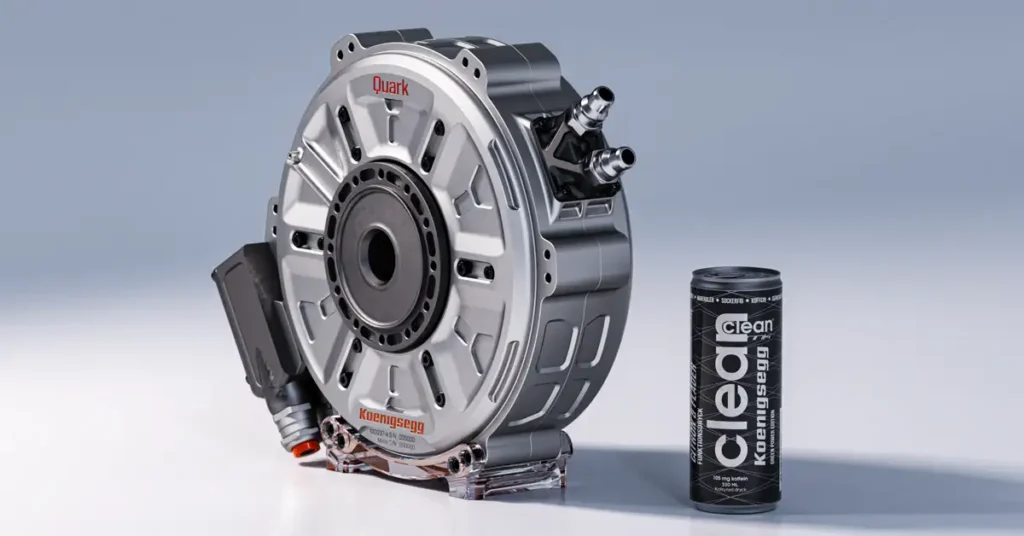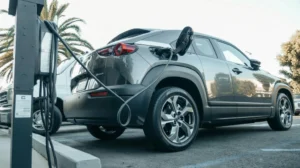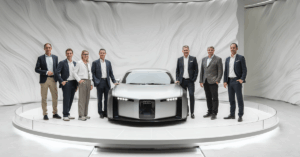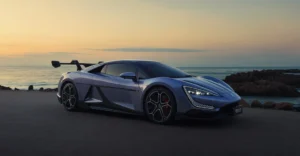Image reference: https://www.koenigsegg.com/
Imagine a motor so small and powerful that it can fit in a full-size backpack but still produces enough power to outgun most gasoline engines. Koenigsegg’s Dark Matter e-motor does exactly that. Debuting in the four-seat Gemera hypercar, this compact powerhouse redefines what electric propulsion can achieve. It blends extreme performance with cutting-edge engineering, giving designers and engineers the freedom to rethink hybrid and fully electric vehicles. In this post, we’ll explore what makes the Dark Matter motor revolutionary, how it works, and why it could influence not just hypercars but also motorcycles, urban EVs, and even aerospace designs.
Why the Dark Matter Motor is a Game-Changer
The Dark Matter motor is remarkable because it delivers 800 hp and 922 lb-ft (1,250 Nm) of torque while weighing only 39 kg. That’s lighter than many single-cylinder motorcycles but far more powerful than most car engines. Koenigsegg’s design challenges the idea that high-output motors need to be large and heavy.
Problem-Agitate-Solution: Most EV motors are either too bulky for compact designs or don’t provide enough torque for high-performance applications. Koenigsegg solved this by combining radial and axial flux designs into a hybrid “raxial” configuration. This unique design maximizes torque delivery while keeping the motor compact. Carbon-fiber composites reduce weight further while maintaining strength, proving that extreme power can be portable and efficient.
The Innovative Raxial Design
To understand why the Dark Matter motor is so unique, it helps to look at its “raxial” design. Radial flux motors, which are common in EVs, generate power through a spinning rotor surrounded by radially arranged magnetic coils. Axial flux motors are smaller and deliver higher torque density using flat rotors and stators stacked face-to-face.
Koenigsegg merged these two systems into the raxial design. This allows the motor to achieve maximum torque without overheating, even under prolonged high-performance driving. The result is a lightweight, compact, and extremely efficient motor that maintains stability and reliability.
Extra Insight: Innovations like this show that breakthroughs in motor architecture, not just battery improvements, can unlock entirely new levels of performance.
Power Delivery and Six-Phase Technology
Most EV motors operate on a three-phase system, energizing electromagnetic windings in sequence. Koenigsegg doubled this to a six-phase system, using two independent three-phase windings. This creates smoother power delivery, reduces vibrations, and lowers noise. It also enhances reliability under extreme conditions.
The motor pairs with a silicon carbide inverter named David, which weighs just 15 kg and can handle up to 850 volts and 1,300 amps. Silicon carbide semiconductors switch faster and have lower resistance than traditional transistors. This minimizes heat loss and ensures consistent performance even at maximum output.
Powering the Koenigsegg Gemera
The first vehicle to feature the Dark Matter motor is the 2025 Koenigsegg Gemera. This four-seat hybrid hypercar combines daily usability with supercar performance. Paired with a 5.0-liter twin-turbo V8, the motor delivers a combined 2,300 hp and 2,028 lb-ft (2,750 Nm) of torque.
Problem-Agitate-Solution: High-performance hybrids often use multiple motors, increasing weight and complexity. Koenigsegg’s single Dark Matter motor simplifies the drivetrain while maintaining extreme performance. Drivers enjoy hypercar acceleration while still being able to carry passengers and luggage comfortably.
Potential Applications Beyond Hypercars
The compact nature of the Dark Matter motor makes it versatile beyond hypercars.
- Urban Mobility: Motorcycles, scooters, and small EVs could gain supercar-like acceleration in a lightweight package.
- Motorsports: Spec racing series could use these motors for high-performance, low-weight EVs.
- Aerospace: Electric vertical takeoff and landing aircraft need small, high-output motors. The Dark Matter design could improve payload capacity without affecting range or stability.
Extra Insight: Koenigsegg’s breakthrough shows that innovation in motor design can reshape multiple industries, not just automotive.
Comparison With Competitors
| Feature | Koenigsegg Dark Matter | Tesla Model S Plaid | Rimac Nevera |
| Horsepower per motor | 800 hp | ~349 hp | 450 hp |
| Torque | 922 lb-ft (1,250 Nm) | ~485 lb-ft (657 Nm) | ~470 lb-ft (637 Nm) |
| Motor Weight | 39 kg | ~45 kg | ~50 kg |
| Voltage | 850 V | 400 V | 800 V |
| Cooling | Liquid + carbon sink | Liquid | Liquid |
| Design | Raxial | Radial | Radial |
| Phase System | 6 | 3 | 3 |
The Dark Matter motor leads in torque-to-weight ratio and packaging efficiency, making it ideal for performance-oriented vehicles. Its lightweight design and compact size give it advantages in both high-performance and urban mobility applications.
What’s Next for Koenigsegg
While Koenigsegg may not license the technology immediately, the Dark Matter motor is likely to influence future vehicles. Scaled-down versions could power lighter EVs, electric-only cars, or even motorcycles. The company may continue to explore compact, high-output designs to deliver unprecedented acceleration and efficiency in various vehicle segments.
Frequently Asked Questions
Can the Dark Matter motor fit in small vehicles?
Yes. Its backpack-sized packaging allows integration into motorcycles, ATVs, and compact EVs.
How much power does it produce?
It delivers 800 hp and 922 lb-ft (1,250 Nm) of torque.
Is it limited to hypercars?
No. It has potential applications in urban EVs, motorsports, and even aerospace vehicles.
What makes it different from other EV motors?
Its raxial design, six-phase system, carbon-fiber construction, and silicon carbide inverter combine efficiency, extreme torque, and compactness.
Why It Matters
The Dark Matter motor shows that innovation in electric motor design is just as important as battery improvements. By rethinking how motors generate and deliver power, Koenigsegg has created a solution that is lightweight, powerful, and versatile. Future small vehicles could offer exhilarating acceleration and efficiency previously only possible in hypercars. This breakthrough may redefine performance expectations for EVs in the coming decade.



